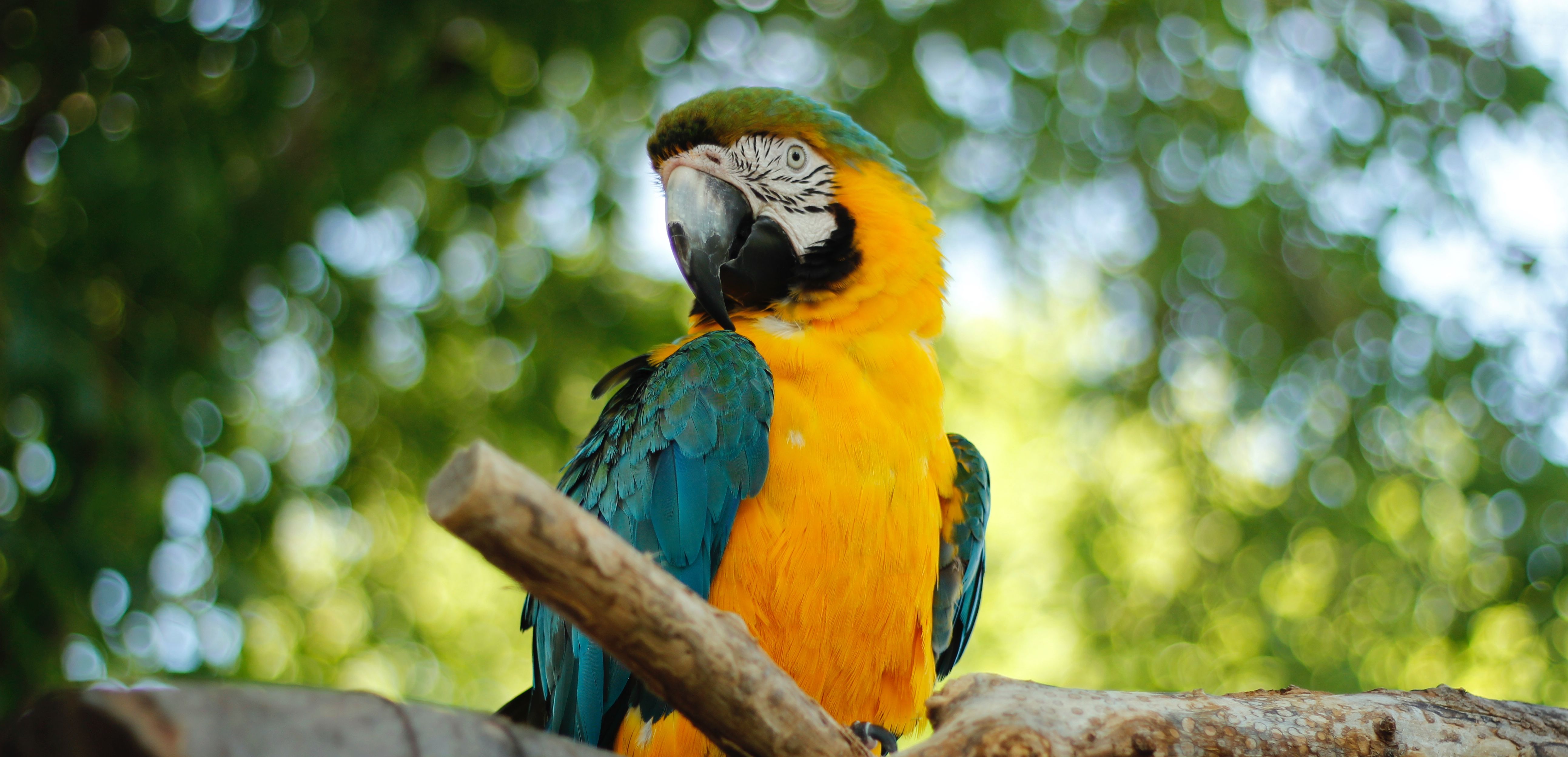Animals
Lincoln Children’s Zoo is home to over 400 animals including giraffes, cheetahs, tigers, giant anteaters, red pandas, Humboldt penguins, ring-tailed lemurs, and Galapagos tortoises. Learn more about each of the animals that live here by exploring the areas below.
*This is not an all inclusive list of the animals at Lincoln Children's Zoo
-
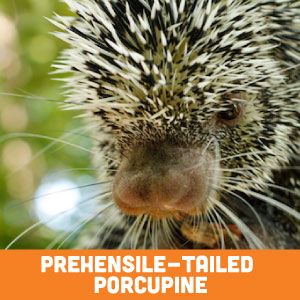
Prehensile-tailed Porcupine
Coendou prehensilisCONSERVATION STATUS
Least ConcernNATURAL HABITAT
Prehensile-tailed porcupines live in trees in South American forests.DIET
IN THE WILD – Leaves, flowers, roots, shoots
IN THE ZOO – Fruit/vegetable mix, rodent blockFASCINATING FACTS
• DNA tests are needed to find out if the porcupine is male or female
• Stomps its feet to scare attackers
• Are nocturnaL
• Renzo’s favorite treat is peanuts! -
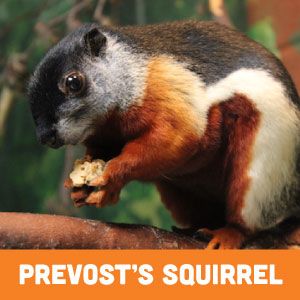
Prevost's Squirrel
Callosciurus prevostiiCONSERVATION STATUS
Least ConcernNATURAL HABITAT
The Prevost's squirrel is found in the trees of dense rain forests.DIET
IN THE WILD – Fruits, nuts, seeds, buds, flowers, insects and bird eggs
IN THE ZOO – Fruits, vegetables, rodent blocks and protein biscuitsFASCINATING FACTS
• Carries fruit away from trees and drops the seeds on the ground, producing new plants
• One-year-olds can have up to 3 litters of young each year
• Each litter can have 1 to 4 young
• Uses tail for balance when running and climbing and as a rudder when jumping
• Communicates by trilling, whistling or raising tail -

Red Panda
Ailurus fulgensCONSERVATION STATUS
EndangeredNATURAL HABITAT
The Red panda prefers to live in mountainous mixed deciduous and conifer forests with old trees and dense under stories of bamboo.DIET
IN THE WILD – Bamboo, berries, nuts, eggs, flowers and seeds
IN THE ZOO – Bamboo, apples and specially formulated biscuitsFASCINATING FACTS
• Communicate with chipmunk-like sound
• Long bushy tail helps balance in trees and provides cover when sleeping
• Have many nicknames- fire cat, lesser panda, common panda and more
• Can eat 80 pounds of bamboo in one day living in the wild
• Excellent tree climbers -

Red-Eared Slider Turtle
Trachemys scripta elegansCONSERVATION STATUS
Least ConcernNATURAL HABITAT
The red-eared slider inhabits areas with source of still, warm water, such as ponds, lakes, swamps, creeks, streams or slow-flowing rivers.DIET
IN THE WILD – Omnivore, meaning they eat both plants and animals
IN THE ZOO – Turtle chowFASCINATING FACTS
• Excellent swimmers, almost entirely aquatic
• Like to leave water to sunbathe to regulate body temperature
• Do not hibernate, but brumate (become less active) in winter
• Have webbed feet to help them swim
• Can live up to 30 years -

Reticulated Giraffe
Giraffa camelopardalis reticulataCONSERVATION STATUS
VulnerableNATURAL HABITAT
The reticulated giraffe is found in in the savannas of Africa.DIET
IN THE WILD – Leaves, fruits and seedpods
IN THE ZOO – Grass, hay, grain and browse (leaves)FASCINATING FACTS
• Spot patterns are completely unique to each individual
• Have a gestation period of 15 months
• Tallest living land mammal reaching heights up to 18 feet
• Only have seven bones in their neck
• Heart can weigh up to 22 pounds and measure up to two feet
• Sleep between 3 to 5 hours per day -
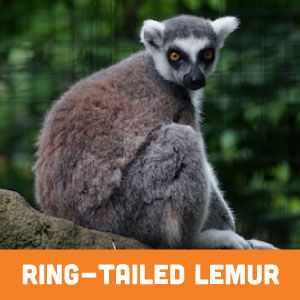
Ring-Tailed Lemur
Lemur cattaCONSERVATION STATUS
EndangeredNATURAL HABITAT
The ring-tailed lemur is found in arid, open areas and forests. They spend their time in the trees, as well as on the floor of the forest.DIET
IN THE WILD – Leaves, flowers, insects, tree bark and sap
IN THE ZOO – Fruits, vegetables, specially formulated fiber biscuits and lemur gelFASCINATING FACTS
• Enjoy sunbathing
• Females are dominant over males
• Tails are ringed with 13 alternating black and white bands and can measure up to two feet long
• Groom each other with their toothcomb, six finely spaced bottom teeth -

Scarlet Ibis
Eudocimus ruberCONSERVATION STATUS
Least ConcernNATURAL HABITAT
The Scarlet Ibis lives in mudflats, estuaries, shorelines and shallow bay areas.DIET
IN THE WILD – Crustaceans, mollusks, fish, insects, frogs and small snakes
IN THE ZOO – Meat, fish, insects and grainFASCINATING FACTS
• Live up to 20 years
• Males and females guard the nest and help feed the chicks
• Curved, slender bill allows them to probe into water, mud or grass for food
• Fly in v-formation to decrease wind resistance for trailing birds, similar to the technique of drafting in car racing -

Slender-tailed Meerkat
Suricata suricattaCONSERVATION STATUS
Least ConcernNATURAL HABITAT
Meerkats live in desert or rocky terrain in Southern Africa.DIET
IN THE WILD – Insects, small rodents
IN THE ZOO – Fruit, vegetables, bird eggsFASCINATING FACTS
• Live in large groups with alpha male and female in charge
• Live underground
• At least one meerkat always in charge of watching out for the group as sentry
• Dark fur around eyes protects eyes from sun
• Can eat scorpions -

Snowy Egret
Egretta thulaCONSERVATION STATUS
Least ConcernNATURAL HABITAT
The Snowy egret lives in marshes, swamps, ponds, lakes and coastal regions.DIET
IN THE WILD – Reptiles, insects, small fish, fiddler crabs and other crustaceans
IN THE ZOO – Meat, fish, insects and grainFASCINATING FACTS
• Eggs are incubated by both adults.
• Stir up bottom of water with one foot to make prey visible.
• Evidence shows that egret pairs do not recognize each other except at the nest and must display an elaborate greeting ceremony in order to be known.
• At the end of the nineteenth century, feathers were used to adorn women's hats and the high demand made them worth twice the price of gold at the time. -
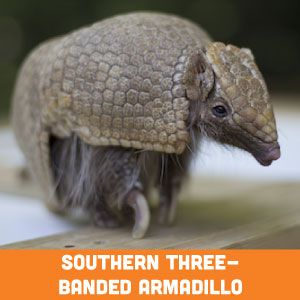
Southern Three-banded Armadillo
Tolypeutes matacusCONSERVATION STATUS
Near ThreatenedNATURAL HABITAT
The three-banded armadillo lives in farmlands and semi-arid regions of lowlands.DIET
IN THE WILD – Beetle larvae, ants, termites and fruit
IN THE ZOO – Insects, fruits and vegetablesFASCINATING FACTS
• Only armadillo that can roll into a ball
• Only mammal with a shell
• Babies are born blind
• Have a lifespan of 20 years -
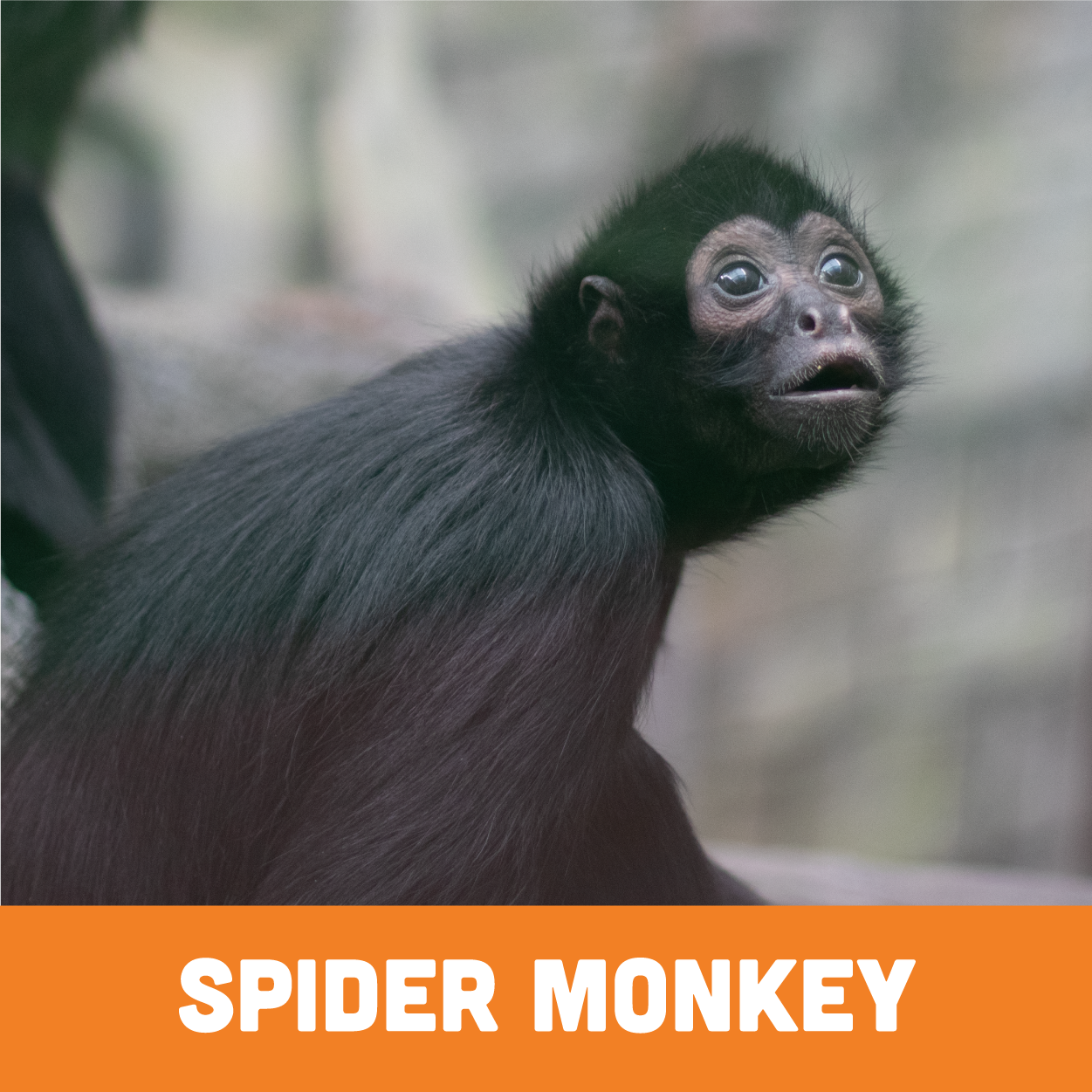
Spider Monkey
Ateles fusciceps robustusCONSERVATION STATUS
Critically EndangeredNATURAL HABITAT
The spider monkey is found in tropical and subtropical forests.DIET
IN THE WILD – Young leaves, nuts, buds, seeds and invertebrates
IN THE ZOO – Fruit, vegetables and fiber type biscuitsFASCINATING FACTS
• Are arboreal, found primarily in tree tops
• Use their prehensile tail as an additional limb
• Tail has a hairless patch on the underside that is used for gripping to branches
• Found in social groups of 3 to 30 in the wild
• Females give birth on average every three years -
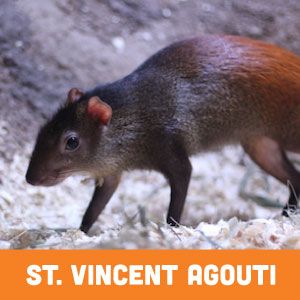
St. Vincent Agouti
Tolypeutes matacusCONSERVATION STATUS
Least ConcernNATURAL HABITAT
St. Vincent agoutis are found in tropical and dry forests of Central and South America.DIET
IN THE WILD – Fruit, nuts, shoots and leaves
IN THE ZOO – Fruit, vegetables, seeds and nutsFASCINATING FACTS
• 13 different species of agoutis exist
• Only known species of agouti to be able to open the husk of a Brazil nut
• Will sometimes bury nuts underground to dig up later
• Communicate through grunts, squeals, screams and various postures
• Mate for life -
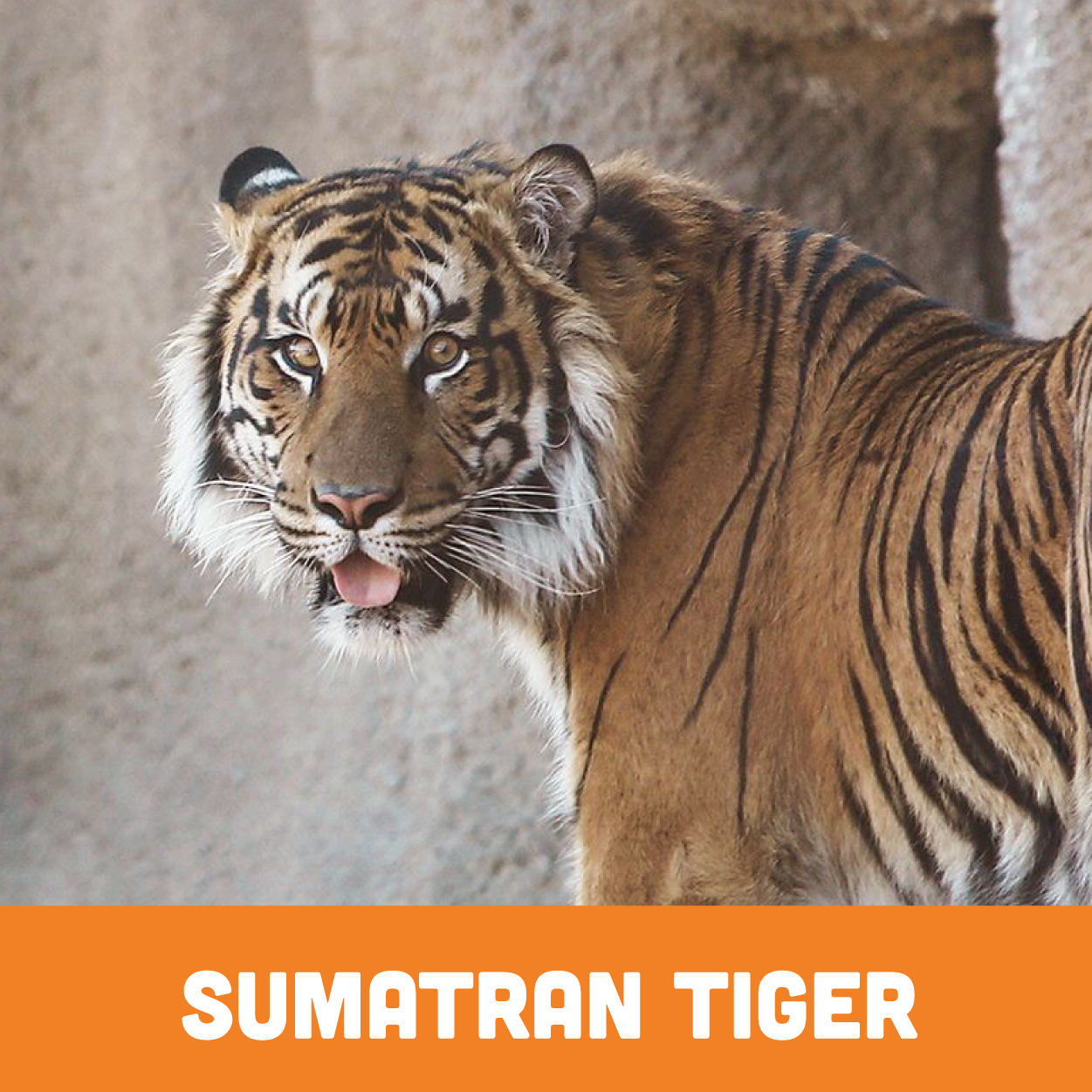
Sumatran Tigers
Panthera tigris sumatraeCONSERVATION STATUS
Critically EndangeredNATURAL HABITAT
The Sumatran tiger is found in tropical forest and grasslands.DIET
IN THE WILD – Variety of deer, wild boar, reptiles, birds and fish
IN THE ZOO – Meat, whole prey and large bonesFASCINATING FACTS
• Sumatran tigers are the smallest of all tiger species
• Tigers are typically solitary cats
• Every tiger’s stripes are unique
• Excellent swimmers and often swim to cool off and play
• Communicate through roaring, grunting and chuffing as well as scent marking and scratch marks on trees -
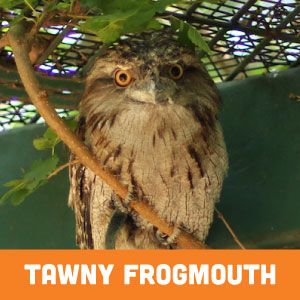
Tawny Frogmouth
Podargus strigoidesCONSERVATION STATUS
Least ConcernNATURAL HABITAT
The Tawny Frogmouth lives in forests, woodlands, urban and rural areas.DIET
IN THE WILD – Insects and small mammals
IN THE ZOO – Insects and rodentsFASCINATING FACTS
• Camouflage feathers allow them to blend in with tree branches
• Often mistaken for an owl
• Catch prey with beak because their feet are weak
• Male and females pair together for life -

Two-toed Sloth
Choloepus didactylusCONSERVATION STATUS
Least ConcernNATURAL HABITAT
The two-toed sloth lives in the trees of tropical forests.DIET
IN THE WILD – Leaves, fruits, nuts, berries, bark, native flowers and small rodents
IN THE ZOO – Fruits, vegetables and hard-boiled eggsFASCINATING FACTS
• Females give birth upside down
• Take up to one month to digest their food
• Cannot walk so they pull hand-over-hand to move
• Will drop from trees into the water to swim across rivers
• Algae grows on fur, giving them a greenish tint
Conservation
Lincoln Children’s Zoo is committed to animal conservation efforts and saving animals from extinction. Home to over 30 endangered animals, the Zoo strives to provide the highest-quality care to these near extinct species. Lincoln Children’s Zoo partners with organizations throughout the world that manage captive animals and wild animals with a goal to create a plan to ensure endangered animals are saved and protected for future generations.
The Zoo is part of the Association of Zoos & Aquarium’s Species Survival Plan, which oversees the management of select species with the goal of enhancing conservation in the wild. Species Survival Plan is led by expert advisors who work together to manage the demographic distribution and long-term sustainability of nearly 500 species.
Photo Ark Collaboration
Lincoln Children’s Zoo collaborates with National Geographic photographer Joel Sartore and his Photo Ark project. The Photo Ark is a groundbreaking effort to document species before they disappear and to get people to care while there’s still time. The Photo Ark started at Lincoln Children’s Zoo with the first photograph taken of a naked mole rat. To date the Photo Ark has documented 10,531 species. Find out more about Joel Sartore’s Photo Ark here.

